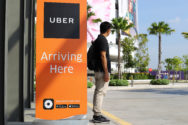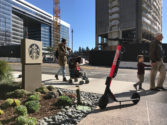What is a TNC?
A TNC is a Transportation Network Company, defined as a digital application that matches potential riders with drivers in real time. Popular TNCs include Uber, Lyft, DiDi, Taxify, among many others. While TNCs have existed for over a decade, cities are still grappling with how to regulate them within a larger infrastructural, political, and revenue producing context.
In a new report, Ride Fair: A Policy Framework for Managing Transportation Network Companies, ITDP presents city officials with a framework for regulating TNCs to maximize their benefits like adding connectivity to transit and other destinations as well as supporting a more car-light or fully car-free population while also mitigating potential hindrances like increased congestion and political pushback.

This paper is accompanied by a webinar. You can view the recording and presentation slides here.
This paper includes four case studies from cities throughout the world and how they have approached regulation challenges.
One of the preliminary challenges in regulating TNCs is that of categorization. Should TNCs be regulated like transportation companies or technology companies? Now that many TNCs are moving into other forms of transportation like bike and scooter sharing, automobile based categorization may not be sufficient. It is important to remember that the category chosen for TNCs will determine which government body or department oversees their regulation.
Once a TNC is properly categorized, a city must determine their overall transportation objectives and how TNCs will fit into those. Careful management of TNCs can position them to align with city objectives to reduce emission rates and congestion, extend and improve the reach of existing public transit systems, and decrease car usage and car ownership.
It is clear that while TNCs are increasingly popular (with ridership and kilometers traveled having increased globally) they will never substitute for a robust transit network or compact, pedestrian-friendly development. However, in some cases, TNCs are able to meet more complex transportation needs like assisting passengers with limited mobility or who are carrying goods. Thus, TNCs need to be regulated to capitalize on their important role as a complementary transportation service while ensuring they do not pull riders from transit, biking, and walking.
Cities should include four key elements in their TNC regulations: pricing, metrics, data, and regional coordination. Pricing strategies should incentivize shorter, shared, and less frequent TNC trips. There are many methods like surcharges, congestion pricing, pricing per kilometer traveled that can encourage certain behaviors like shorter or less frequent trips or decreasing congestion during peak hours. Pricing TNCs (and other vehicles, in the case of congestion pricing) can generate revenue to support public transit and achieve efficiency.
Cities should also establish baselines and metrics to evaluate the impacts of TNCs. Measuring the extent to which TNCs are affecting equitable access, congestion, safety and emissions can help to amend policies where appropriate and improve regulation and the role of TNCs in cities.
 Finally, cities should consider opportunities to regulate TNCs on a regional scale, given the tendency of TNC trips to cross municipal, county, or even state lines. A good example of regional coordination of TNCs is in Greater London, where Transport for London oversees the management of TNCs and other private hire vehicles for the City of London and its surrounding 32 burroughs. Regional coordination can help minimize administrative costs of regulation, and provide consistency in enforcement. Even if coordination is not officially placed under the purview of a regional body, standardizing regulations across neighboring municipalities can achieve similar results. Many cities have struggled to adequately regulate TNCs due to a number of structural barriers including a lack of political will, resistance from existing transportation modes like taxis, or a lack of capacity in government. The report identifies these and other potential barriers, and offers recommendations that can move cities closer to adopting outcome-oriented TNC regulations.
Finally, cities should consider opportunities to regulate TNCs on a regional scale, given the tendency of TNC trips to cross municipal, county, or even state lines. A good example of regional coordination of TNCs is in Greater London, where Transport for London oversees the management of TNCs and other private hire vehicles for the City of London and its surrounding 32 burroughs. Regional coordination can help minimize administrative costs of regulation, and provide consistency in enforcement. Even if coordination is not officially placed under the purview of a regional body, standardizing regulations across neighboring municipalities can achieve similar results. Many cities have struggled to adequately regulate TNCs due to a number of structural barriers including a lack of political will, resistance from existing transportation modes like taxis, or a lack of capacity in government. The report identifies these and other potential barriers, and offers recommendations that can move cities closer to adopting outcome-oriented TNC regulations.
Ultimately, as demand for TNCs continues to rise, it is up to cities to define their goals for TNC service provision and design and enforce regulations that move TNCs toward achieving those goals.



